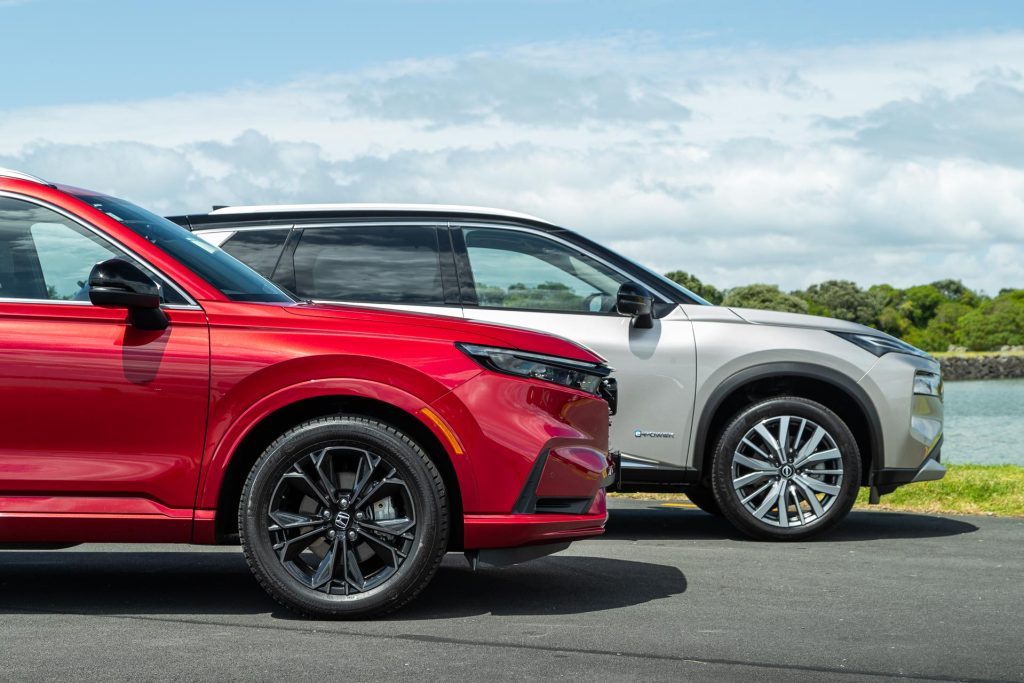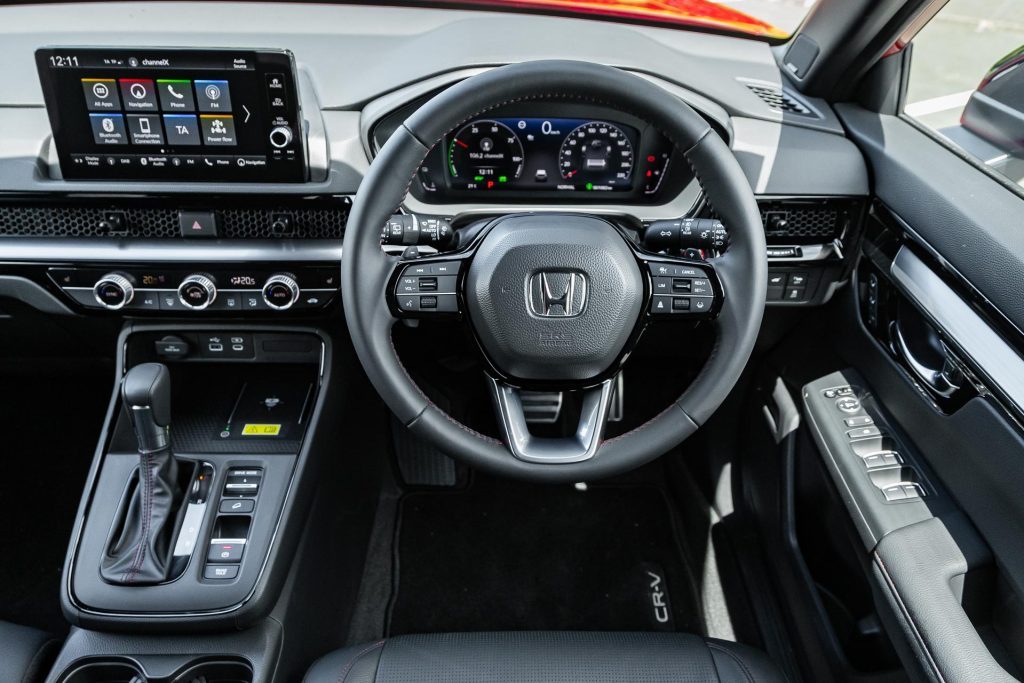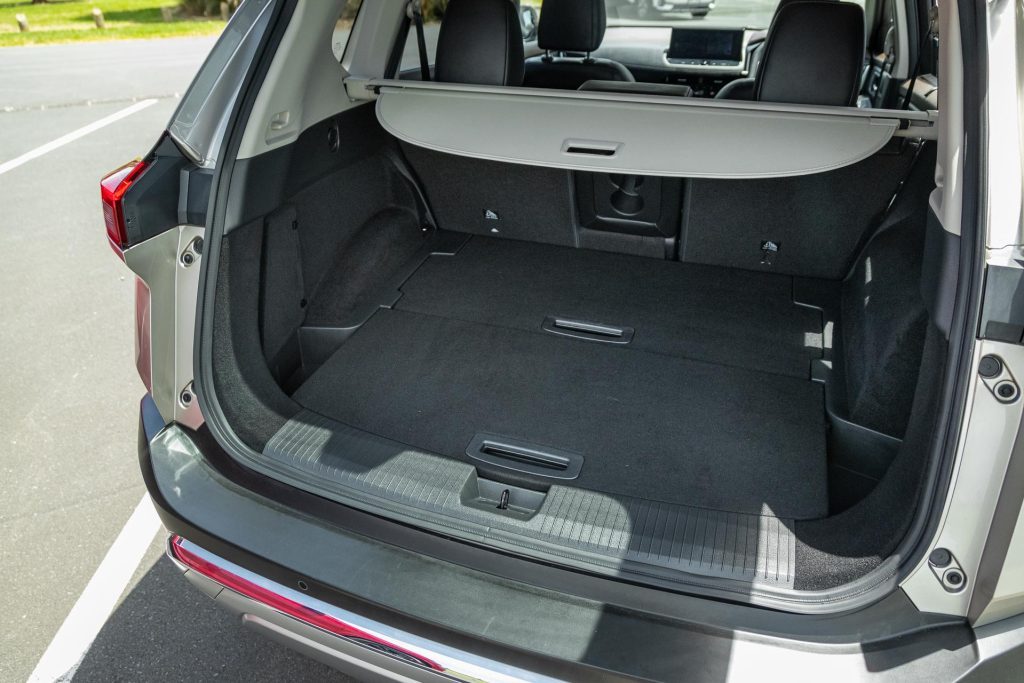2023 Honda CR-V RS vs Nissan X-Trail e-Power Ti-L comparison review
Words: Kyle Cassidy | Photos: Isaac Western
Medium SUVs aren’t something to get too excited about, yet they are hard to beat when it comes to general competence. If you want a hybrid and don’t fancy waiting a year for a Toyota RAV4, these two are worthy.
Every month, it’s the same type of vehicle that proves to be the most popular with NZ buyers. And that’s the ‘medium SUV’ as marketers call them.
For the unwashed, that’s a high-riding wagon sort of thing that is not too big or too petite, but sized about right for the average Kiwi family, both young and old. And that is why just about every brand has a medium SUV in its ranks, and it’s often its best seller.

The CR-V, now in its sixth generation, is Honda’s best seller globally, although it plays second fiddle to Jazz here in NZ. Nissan’s entrant into the biggest segment is the X-Trail, which is now in its fourth generation.
It too is Nissan’s biggest global seller, as it is here, outselling Navara last year, although the Clean Car scheme might have had a hand in that result.
New for both models here in NZ is the addition of a hybrid option. The e-Power debuted early last year, and has since accounted for around one-third of X-Trail sales.
New to the Honda CR-V range is the hybrid RS. These hybrids offer reduced fuel consumption and easy-going progress thanks to their petrol-electric arrangements. Which is the better choice?

What are the figures?
The CR-V RS and X-Trail Ti-L line up here equal on price, coming in at $67k before on-road costs.
There is only one CR-V hybrid, the RS, which commands quite a premium over its conventionally powered variants, the 1.5T AWD Sport being $53k and the $57k Sport 7.
X-Trail can be had with e-Power in both ST-L and Ti-L grades, both an extra $7k over the equivalent 2.5-litre model. Worth the premium then? Both these hybrids offer improved outputs when compared with their pure ICE counterparts, and also lower fuel use.

In the Nissan’s case, the e-Power returns a stated 6.8L/100km (154 g/km) while the figures for the 2.5 model are 8.7L/100km and 204g/km. Honda reckons its hybrid is a little better at 6.4L/100km (146g/km) which compares with the 1.5T’s 8.2L/100km and 189g/km.
They both deliver improved power and torque figures, the Honda with 135kW and 335Nm, the Nissan boasting 195kW and 330Nm.
Although it’s not so much about outright pace but rather ease of the drive that appeals with these hybrids.

How do they work?
Both use a petrol-fired engine to turn a generator which charges a small lithium-ion battery. This battery is used to power an electric motor (or motors in the X-Trail’s case) which is used to propel the vehicle.
The Honda is a little more complicated in that in some circumstances the engine can be used to turn the drive wheels, but essentially these operate more like EVs than ICE-powered vehicles.
The main difference between them is that the Nissan has a motor on the rear axle as well while the Honda is a front-driver.

But without conventional transmissions or an engine that needs to spin before it generates its best, these too have plenty of smooth and available torque for easy driving.
With an additional motor to provide extra thrust, the X-Trail feels more effortless in its delivery, and is the quicker of the two.
Like most EV types, they feel strong in the 20-80km/h zone, though the ‘surge’ starts to diminish as they reach open road speeds. What’s likeable is there’s no waiting for gears to sort themselves here as they just roll on sweetly.
Because they have engines, they do make a noise and sometimes it’s a bit intrusive when accelerating. They also fire up relatively often as the battery needs a constant supply of energy.

They do however shut down on a light throttle and when stopped. However, the overall experience would be better still if the engines were more muffled and vibrations were better isolated.
The Honda is a little better on fuel use, around the 7.0L/100km mark on test while the X-Trail was on 7.6. And the CR-V can be filled with 91, the Nissan requiring premium. These figures you could probably improve on by driving in Eco mode, though progress feels a tad nobbled.
There are fewer drive modes to worry about in the CR-V, Honda keeping things simple in that regard.
Nissan has perhaps added too many with an EV mode (only really useful for low speed ramblings otherwise you get a ‘not available due to acceleration demand’ message).

There’s also the e-Pedal setting which adds strong motor regen when you release the throttle, giving a one-pedal drive mode. And there are others like off-road and snow.
Just leave it in Auto and be done with it. Both SUVs have a B mode, easily slotted via the gear selector to add motor regen when off the gas.
It’s more effective in the Nissan (we guess because it has two motors in action) whereas it’s not really in the Honda, and therefore rarely utilised.
How do they drive?
Around town and on the highway, the X-Trail has a softer approach, with a more absorbent ride character. The steering is lighter on both weighting and feel.

The CR-V has a slightly sportier persona to its progress, the low-speed ride not quite as plush, but its ‘twin piston dampers’ deal with the big bumps of a lumpy highway road competently.
The Honda has a better feel at its wheel, making a decent connection (for a medium SUV anyway). Come time for a corner, it turns more keenly, the body movements kept tidier.
With astute electronic driving aids, it’s difficult to induce understeer with torque vectoring by brake keeping it on course. The Honda has a pretty good brake pedal feel too.

The Nissan isn’t quite as athletic, its turn is more relaxed, with less of a connection. There are a few degrees more roll as you round the bend, and it’ll move around at the rear over the bumpier stuff.
The brake pedal has an inconsistent feel at highway speeds too, so the B mode can therefore be more appealing, a lift of the throttle slowing the X-Trail enough for most bends.
There are obvious traction advantages from Nissan’s AWD operation to let you roam a little further and the X-Trail has a superior tow rating too, with a 1650kg braked capacity to the Honda’s 750kg.

Are the driver aids behaved?
The Nissan has the more polished active cruise, the Pro Pilot system calmer on the turns and smoother with its lane tracing.
The lane departure isn’t as insistent either yet does the job when required. This it does with a gentle application of the brakes to help pull it back into the lane, which to us feels less invasive than the system tugging away at the steering wheel.

The Honda’s lane departure mitigation system is overly keen in its default mode, and while you can’t switch it off completely, you can temper its enthusiasm in the driver assistance settings.
Thankfully, both keep the safety warnings to a minimum.
The pragmatic choice
The key reason for the SUV’s popularity is practicality; they fit the family and all of their wares. These two are about even for leg room in the back, both with wide opening doors for ease of entry.
The Nissan has superior seat comfort, and it’ll be cosier in winter with its seat heaters while the retractable window shades will help in summer.


Neither of these features is present in the Honda, nor is there Nissan’s third zone of climate control. Both have the usual Isofix, USB charge ports, and a recline function for the seat back.
The Nissan’s bench can also slide forward if you happen to require not so much leg room and more boot space.
On the latter, CR-V has a slight edge on volume, its hold being longer and taller. Neither has a spare wheel and little to no underfloor storage.
The X-Trail has a two-piece false floor that serves little real purpose, while the boards make a crashing noise when you cruise over speed bumps.


Up front, Nissan’s double-stitched surface linings help impart a classier ambience, while there are more abundant soft spots. These include the seats which are more supple and covered in a finer grain leather.
The Honda’s seat is a little firm, while the steering wheel needs more reach adjustment.
Both have enough practical storage and neither frustrates with their minor controls as each has plenty of buttons to perform regular tasks.
The Nissan’s infotainment system edges the Honda’s with a few more functions, a quicker response and better resolution. Both have a charge pad, CarPlay and Android Auto connectivity.


The Honda has the better outward vision, while the Nissan has the superior parking camera, complete with a 360 degree monitor.
The CR-V owner gets the Honda Connect app and, if you find the key too bulky, just put the key card in your wallet, and it’ll do the same job.
Both have big glass roofs, keyless entry, powered boots with a kick-to-open function while Nissan adds a few extras like self parking, a wheel warmer and powered seats on both sides of the cabin.

Honda’s price is non-negotiable, and it comes with a five-year unlimited-kay warranty. Nissan’s five-year cover is limited to 150,000km. Both offer a fixed-price service plan so you can lock in those costs.
The winner then?
It’s hard to pick a clear winner between these two, each well matched in most areas, though the X-Trail’s additional kit and level of luxury will likely do it for most, especially if you’re looking for something cosseting.

It’s AWD too, and can haul more. The Honda is a little better on gas, and is slightly more engaging from the driver’s seat if that’s your thing.
| Model | Honda CR-V RS |
| Price | $67,000 |
| Engine | 1996cc, IL4, DI |
| Power / Torque | 109kW @ 6100rpm / 183Nm @ 4500rpm |
| Battery | 1.06kWh |
| Motor Output | 135kW / 335Nm |
| Drivetrain | e-CVT, FWD |
| Turning circle | 11.4m (2.3 turns) |
| Fuel Use | 6.4L/100km |
| C02 Output | 146g/km |
| 0-100km/h | 7.85 sec |
| Tyre Size | f/r-235/55/R19 |
| Fuel Capacity | 57L |
| Stability systems | ABS, ESP, TV |
| Safety | AEB, ACC, BSM, LDW, RCTA, ALK, AHB |
| Luggage Capacity | 581-1636L |
| Tow rating | 600kg (750kg braked) |
| Service intervals | 12 months/15,000km |
| Warranty | 5 years/unlimited km |
| ANCAP rating | Not yet rated |
| Weight | 1771kg (claimed) |
| Model | Nissan X-Trail e-Power Ti-L |
| Price | $66,990 |
| Engine | 1500cc, IL3, T, DI |
| Power / Torque | 106kW @ 4400rpm / 250Nm @ 2400rpm |
| Battery | 1.8kWh |
| Motor Output | 195kW / 330Nm |
| Drivetrain | single-speed-auto / AWD |
| Turning circle | 11.1m (2.5 turns) |
| Fuel Use | 6.8L/100km |
| C02 Output | 154g/km |
| 0-100km/h | 6.94 sec |
| Tyre Size | f/r-255/45/R20 |
| Fuel Capacity | 55L |
| Stability systems | ABS, ESP, TV |
| Safety | AEB, ACC, BSM, LDW, RCTA, ALK, AHB |
| Luggage Capacity | 575L |
| Tow rating | 750kg (1650kg braked) |
| Service intervals | 12 months/15,000km |
| Warranty | 5 years/150,000km |
| ANCAP rating | 5 Stars (2022) |
| Weight | 1911kg (claimed) |
This story first appeared in the February 2024 issue of NZ Autocar magazine.





